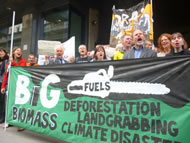Under the guise of ‘green energy’, burning wood in power stations has become a massive growth industry in the UK, with by far the biggest demand coming from coal-fired power station operators. So far, five of them have announced plans to convert, either partly or completely, to biomass. These are Tilbury in Essex, Ironbridge in Shropshire, Eggborough and Drax in Yorkshire, and Lynemouth in Northumberland. Between them these power stations will require almost six times as much wood as the UK produces in total every year. That statistic alone shows just how unsustainable wood-fired power stations are and it spells disaster for the world’s natural habitats, human rights, and our hopes of combating climate change.
A demand for biomass on the scale planned has dire implications. So far, most wood pellets imported to the UK come from Canada and the Southern US, while some are sourced from the Baltic States, Russia and Portugal. In Canada and the Southern US, highly biodiverse forests are already being clear-cut to produce pellets. And across Russia, the Baltic States, the Mediterranean and Scandinavia, biodiverse forests are being destroyed and then turned into monoculture tree plantations for biomass. This trend is likely to worsen as demand for biomass grows in the UK. In the longer term, energy companies are looking at imports from Brazil, West and Central Africa and other regions of the Global South, where trees grow faster and land is cheaper.
At the moment there are few legal restrictions on where biomass can come from, and as the rush for biofuels has already shown, companies usually go for the cheapest growing land they can find. This means a high risk of land-grabbing from some of the world’s poorest people, and rising food prices as land is diverted away from growing food.
Although burning biomass releases less of the chemical sulphur dioxide than burning coal does, it releases more fine particulates and volatile organic compounds. These pose a particularly serious risk of lung and heart disease to communities living in close proximity to power stations. More worrying, however, is the fact that power stations burning wood emit up to 50% more carbon dioxide than those burning coal. Companies and policymakers ignore this carbon, claiming that biomass is green because new trees grow back in the place of those that have been cut down, thereby sequestering the carbon that was emitted in their combustion, making the process carbon neutral. Yet it takes decades before a tree matures sufficiently for that to happen. And when forests are destroyed and turned into monoculture plantations, much of the carbon will simply stay in the atmosphere. Such a carbon spike is a disaster at a time when scientists have shown that human-created emissions and levels of atmospheric CO2 must be reduced rapidly if we are to have any hope of avoiding the worst impacts of climate change.
So how do we keep warm in the future? First, we need to address energy conservation and a reduction in energy consumption. These issues can be resolved in myriad ways and be net job creators, but we need to invest in genuine renewable energy systems, which should be small-scale and community-owned.








